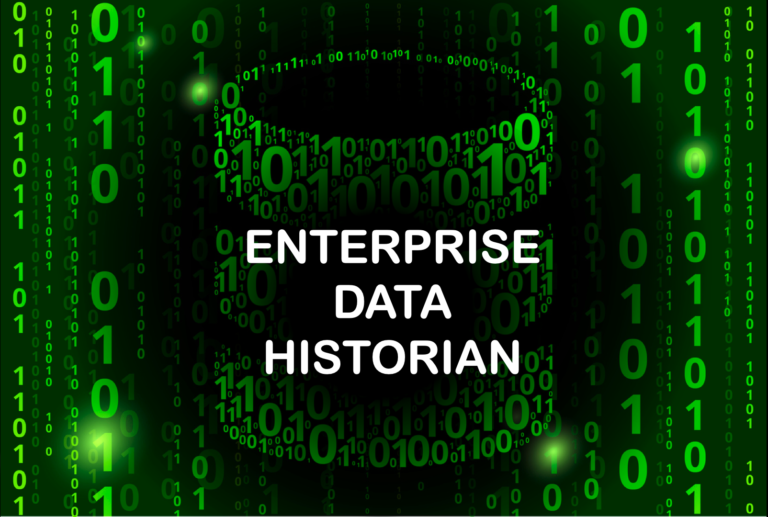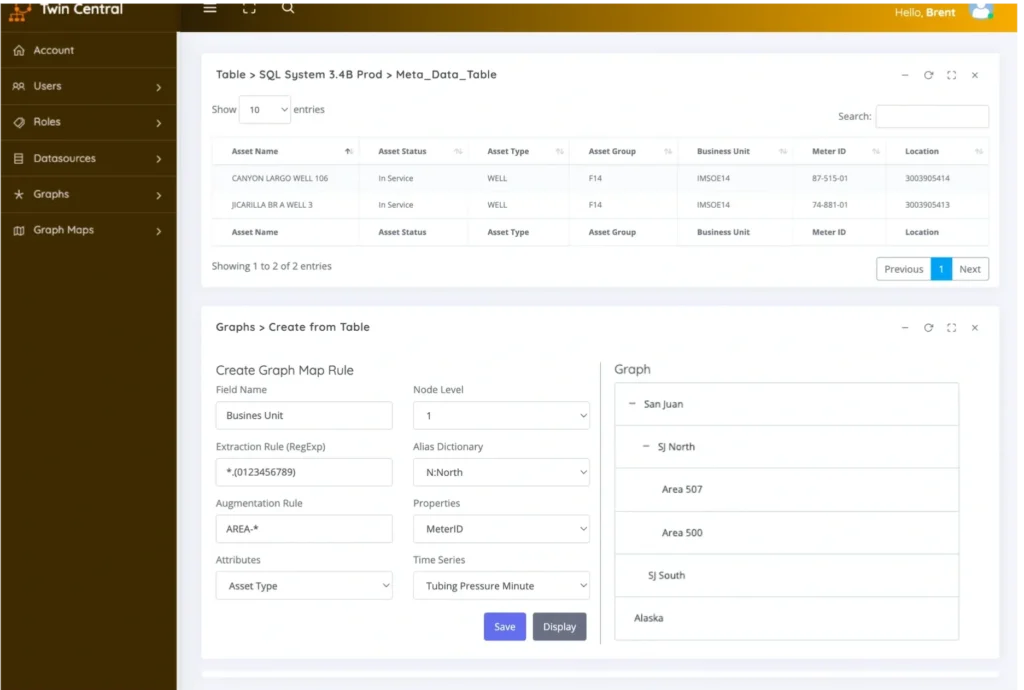
Enterprise Data Historian Solution
An Enterprise Data Historian is a centralized data management system that stores and organizes historical data from various industrial sources, enabling you to analyze, monitor, and optimize your operations. By using an Industrial Data Fabric (IDF) solution and its components – Twin Talk, Twin Sight, and Twin Central – you can design and create an efficient Enterprise Data Historian tailored to your organization’s specific needs.
Twin Talk serves as the foundation for building your Enterprise Data Historian, providing secure and scalable data ingestion from SCADA systems and other data sources to the cloud. This ensures seamless data flow and integration, allowing your Data Historian to serve as a centralized repository for all your operational data.
With Twin Sight, you gain access to an intuitive visualization tool and dashboard builder that makes it easy to analyze and gain insights from your historical data stored in the Enterprise Data Historian. Real-time data access empowers you to make informed, timely decisions, and optimize your operations based on the historical trends and patterns revealed in your data.
Twin Central is the third IDF component that creates a comprehensive semantic data model for managing all your metadata in the Enterprise Data Historian. By linking, mapping, and managing metadata from various sources, Twin Central generates a single source of truth that unifies your organization’s data. This simplification of data management ensures efficient data access and streamlines analytics processes for your Data Historian.
By leveraging the power of the IDF components, you can design an Enterprise Data Historian that serves as a valuable tool for monitoring, analyzing, and optimizing your assets and processes based on historical data. An Enterprise Data Historian not only simplifies data management but also enables you to uncover new opportunities for improvement through advanced analytics, machine learning, and real-time data access. Embrace the potential of an Enterprise Data Historian created with IDF components to transform your operations and maintain a competitive edge in the ever-evolving industrial landscape.
Architecture for a Cloud Historian with Twin Fusion
Designing and implementing an Enterprise Cloud Historian architecture with EOT products is effortless, providing a simple, stable, and fast solution. There’s no need for coding or “Lift and Shift” components like AWS Lambda, AWS Glue, or AWS Kinesis. EOT offers a clean, elegant, and highly performant architecture that stands out in the industry, allowing you to focus on leveraging data for your business growth.
- Start by identifying specific use cases that provide real business value. Utilize Twin Central to create Assets and Data Models, which serve as the Single Source of Truth. This allows you to navigate through industrial assets within the Enterprise Cloud Historian, dashboards, and visualization apps.
- Based on these valuable use cases, use Twin Talk to configure Data Ingestion, Curation, and Contextualization. This enables the transportation and transformation of raw data from Data Sources into the data storage.
- With the selected use cases in mind, train and deploy Analytics and ML models to provide insights for the Enterprise Cloud Historian, dashboards, and visualization apps.
- Finally, use the Enterprise Cloud Historian, dashboards, and visualization apps to display operational, financial, and technical data, as well as insights from analytics and ML systems. This is all based on the specified use cases that drive real business value.
By following these four steps, you can effectively harness the power of an Enterprise Cloud Historian to drive meaningful insights and informed decision-making for your organization.
How to Get Started
The majority of digital transformation efforts fail due to one critical mistake: designing a logical architecture without a specific use case in mind. There are two common, but flawed approaches:
- Attempting to create an architecture that addresses all possible use cases for a company. This is often driven by business consulting firms that spend an excessive amount of time compiling use case lists involving the entire organization.
- Having no use case at all and adopting the mindset of gathering all data first, then discussing potential applications with users.
Both approaches almost certainly lead to costly projects that provide no value or support within the company and may even negatively impact the careers of project leaders. So, how should you get started? Select a use case that has two key attributes: 1) it’s quick to implement, providing a fast time-to-value, and 2) it delivers genuine business value for the company.
Enterprise Data Historian Features and Benefits

Overview
A cloud-based enterprise data historian is a specialized data storage and management system designed to collect, store, and analyze time-series data generated by industrial processes, equipment, and control systems. By leveraging cloud technology, these data historians provide a highly scalable, cost-effective, and secure solution for storing and processing large volumes of historical and real-time data. The primary objective of a cloud-based enterprise data historian is to help industrial companies make data-driven decisions and optimize their operations.
Time-Series Data Storage
Cloud-based data historians excel at handling time-series data from sensors, allowing industrial companies to maintain a comprehensive record of their equipment and process performance. This data enables organizations to analyze the past behavior of their systems and make better-informed decisions about future actions.
Historical Data Analysis
Storing historical sensor data allows companies to perform trend analysis, identify patterns, and uncover insights to optimize processes, improve product quality, and enhance overall operational efficiency. This historical data can also be used to establish baselines for predictive maintenance, reducing downtime, and associated costs.
Real-Time Monitoring and Analytics
Cloud-based data historians support real-time data ingestion and analytics, allowing organizations to monitor and respond to changes in their operations quickly. This capability leads to more proactive decision-making, enhanced efficiency, and reduced downtime.
Anomaly Detection
By analyzing historical sensor data, cloud-based data historians can help companies identify anomalies or deviations from normal operational patterns. This capability can be used to detect potential equipment failures, process inefficiencies, or quality issues, enabling organizations to take corrective action and mitigate risks.
Scalability and Cost Efficiency
Leveraging cloud technology, enterprise data historians offer a scalable storage solution that can grow with the organization’s data needs. This approach eliminates the need for significant upfront capital investments in hardware and infrastructure, reducing costs and allowing for more efficient resource allocation.
Twin Fusion Components for Industrial Data Lake

EOT’s Twin Talk™ serves as a Data Integration Platform for industrial IoT, bridging the gap between operational systems (OT) and cloud (IT) solutions to unlock the untapped value of operational data. This innovative solution eliminates the complexity and costs associated with traditional infrastructure, enabling executives, operators, data scientists, and business analysts to harness AI, machine learning, and analytics for real-time insights and operational intelligence. Twin Talk streamlines the secure transmission of sensor data from assets while maintaining plant safety, allowing companies to focus on enhancing productivity through digitization and driving tangible business value.

EOT’s Twin Central™ facilitates the creation of an asset-centric, single source of truth semantic data model. With Twin Central, business technologists can map, link, store, and synchronize relationships between assets and their operational, engineering, and financial metadata using a unified relationship graph. This straightforward approach enables the creation and management of an asset-centric, single source of truth and semantic data model across the enterprise. Twin Central allows for the development of digital twin data models that map, connect, link, store, and synchronize relationships between assets and their operational, engineering, and financial metadata using a unified digital twin relationship graph.

EOT’s Twin Sight™ offers a modern, rapid prototyping approach to operational dashboard authoring, accelerating the adoption of AI-based anomaly detection, production optimization, and operation monitoring across all production sites. With Twin Sight™, industrial users can leverage the power of low-code AI-driven software to modernize the visualization of asset information and data, driving the rapid creation of use-case-specific visual dashboards, templates, and reports. Twin Sight’s flexibility and ease of use enable any individual within the company to access enterprise-wide operational data through a self-service model and develop dashboards and reports tailored to their specific use case and business needs.




